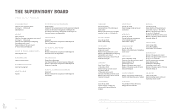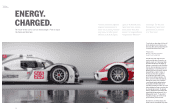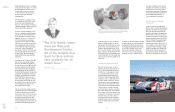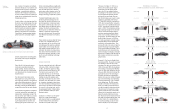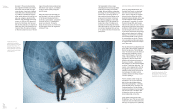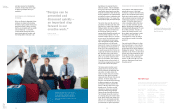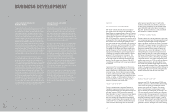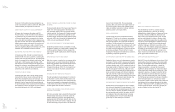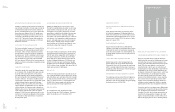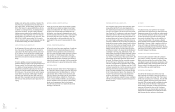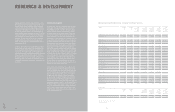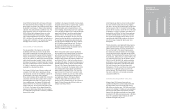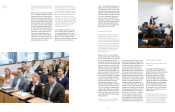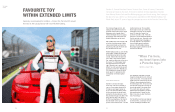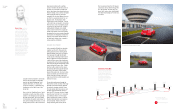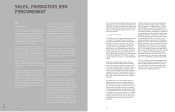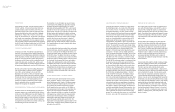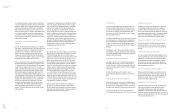Porsche 2014 Annual Report Download - page 29
Download and view the complete annual report
Please find page 29 of the 2014 Porsche annual report below. You can navigate through the pages in the report by either clicking on the pages listed below, or by using the keyword search tool below to find specific information within the annual report.
055054
Annual Report
Porsche AG
2014
Development eorts in nancial year 2014 focussed on
the new generation of the Cayenne model series, which
not only impresses with its sharper design, increased
eciency and comprehensive series tting, but with the
introduction of the Cayenne S E-Hybrid, also presented
the rst plug-in hybrid vehicle in the premium SUV seg-
ment. Additional eorts focussed on the new GT vehicles
Cayman GT4 and the 911 GT3 RS. Porsche Motorsport
also developed the second generation of the Le Mans
prototype: The new Porsche 919 Hybrid is a powerful
evolution of the successful version which débuted in
2014. The new generation’s initial roll-out took place in
mid-December 2014.
In addition, the engineers’ tasks at the Weissach Devel-
opment Centre in nancial year 2014 included work on
the standard drive module toolkit based on the Panam-
era concept. The module serves as the foundation for
vehicles whose engine is installed longitudinally and which
feature rear-wheel drive in the base version. In future,
the module could also be used by other vehicles in the
Volkswagen Group. The toolkits are intended to tap into
considerable synergies in development, procurement and
production.
EXCITING NEW LAUNCHES
In January 2014, Porsche presented the new 911 Targa
to the public at the North American International Auto
Show (NAIAS) in Detroit. It combines the classic Targa
concept with state-of-the-art roof technology. Just like
the original Targa, the new model features a character-
istic wide bar in place of the B-pillars, a movable roof
section above the front seats and a wrap-around rear
window with no C-pillar. However, in a departure from the
classic models, the roof segment on the new Targa can
be opened and closed at the push of a button. The new
Targa generation was released exclusively with all-wheel
drive. The heart of the 911 Targa 4 is a 3.4-litre 350-hp
Boxer engine. The 911 Targa 4S’s engine generates
400-hp. One year later, another Targa stole the spotlight
at the Detroit Auto Show in January 2015 – the 911 Targa
4 GTS. For the rst time, Porsche had implemented the
successful GTS concept in a Targa. At 430 hp, its engine
is even more dynamic. The series includes the Sport
Chrono package, black 20-inch centre lock wheels and
SportDesign front apron, among other features. Black
Alcantara leather on the steering wheel and seats, as
well as trim accents nished in black brushed aluminium
enhance the Targa 4 GTS’s sporty air.
At the Geneva International Motor Show in March 2014,
Porsche focussed on its return to the big motor-sports
stage. The highlight of the event was the world premiere
of the 919 Hybrid, which competed in the 2014 World
Endurance Championship (WEC). Just as in all eight of
the WEC races, the prototype in Geneva was anked
by the 911 RSR. The Macan S Diesel, the fuel-ecient
endurance champion in the Macan model series, also
celebrated its premiere at the Swiss auto show. With fuel
consumption between a mere 6.1 and 6.3litres/100km,
the Macan S Diesel’s CO2 emissions range from 159 to
164 g/km. Despite these numbers, the Macan S Diesel,
with its 3.0-litre V6 turbo diesel engine (258 hp), accel-
erates from 0 to 100km/h in just 6.3 seconds and tops
out at a speed of 230km/h.
RESEARCH & DEVELOPMENT
EMISSION AND CONSUMPTION DATA OF THE NEWLY INTRODUCED VEHICLES
Model Output
(kW)
Output
(hp)
Fuel
consumption
urban
(l/100 km)
Fuel
consumption
extra-urban
(l/100 km)
Fuel
consumption
combined
(l/100 km)
CO2-
emissions
combined
(g/km)
CO2-
efficiency
class
(Germany)
Boxster GTS 243 330 12.7 7.1 9.0 211 G
Boxster GTS PDK 243 330 11.4 6.3 8.2 190 F
Cayman GTS 250 340 12.7 7.1 9.0 211 G
Cayman GTS PDK 250 340 11.4 6.3 8.2 190 F
Cayman GT4 283 385 14.8 7.8 10.3 238 G
911 Carrera GTS 316 430 13.7 7.5 9.5 223 G
911 Carrera GTS PDK 316 430 12.2 6.7 8.7 202 F
911 Carrera GTS Cabriolet 316 430 13.7 7.6 9.7 228 G
911 Carrera GTS Cabriolet PDK 316 430 12.3 6.9 8.9 207 F
911 Carrera 4 GTS 316 430 13.8 7.7 9.9 233 G
911 Carrera 4 GTS PDK 316 430 12.5 7.1 9.1 212 G
911 Carrera 4 GTS Cabriolet 316 430 13.9 7.7 10.0 235 G
911 Carrera 4 GTS Cabriolet PDK 316 430 12.5 7.1 9.2 214 F
911 Targa 4 257 350 13.1 7.5 9.5 223 G
911 Targa 4 PDK 257 350 11.8 6.9 8.7 204 F
911 Targa 4S 294 400 13.9 7.7 10.0 237 G
911 Targa 4S PDK 294 400 12.5 7.1 9.2 214 F
911 Targa 4 GTS 316 430 13.9 7.7 10.0 237 G
911 Targa 4 GTS PDK 316 430 12.5 7.1 9.2 214 F
911 GT3 RS 368 500 19.2 8.9 12.7 296 G
Macan S Diesel 190 258 6.9 – 6.71) 5.9 – 5.71) 6.3 – 6.11) 164 – 1591) B
Cayenne Diesel 193 262 7.8 – 7.61) 6.2 – 6.01) 6.8 – 6.61) 179 – 1731) B
Cayenne S 309 420 13.0 – 12.41) 8.0 – 7.81) 9.8 – 9.51) 229 – 2231) E – D
Cayenne S Diesel 283 385 10.0 7.0 8.0 209 C
Cayenne GTS 324 440 13.2–12.91) 8.3–8.11) 10.0–9.81) 234–2281) E – D
Cayenne Turbo 382 520 15.9 – 15.51) 8.9 – 8.71) 11.5 – 11.21) 267 – 2611) F
Cayenne Turbo S 419 570 15.9 8.9 11.5 267 F
Plug-in hybrid
Model Output
(kW)2)
Output
(hp)2)
Power
consumption
(kWh/100 km)
Fuel
consumption
combined
(l/100 km)
CO2-
emissions
combined
(g/km)
CO2-
efficiency
class
(Germany)
Cayenne S E-Hybrid 306 416 20.8 3.4 79 A+
1) Versatility depending on the tyre set used
2) Overall performance


